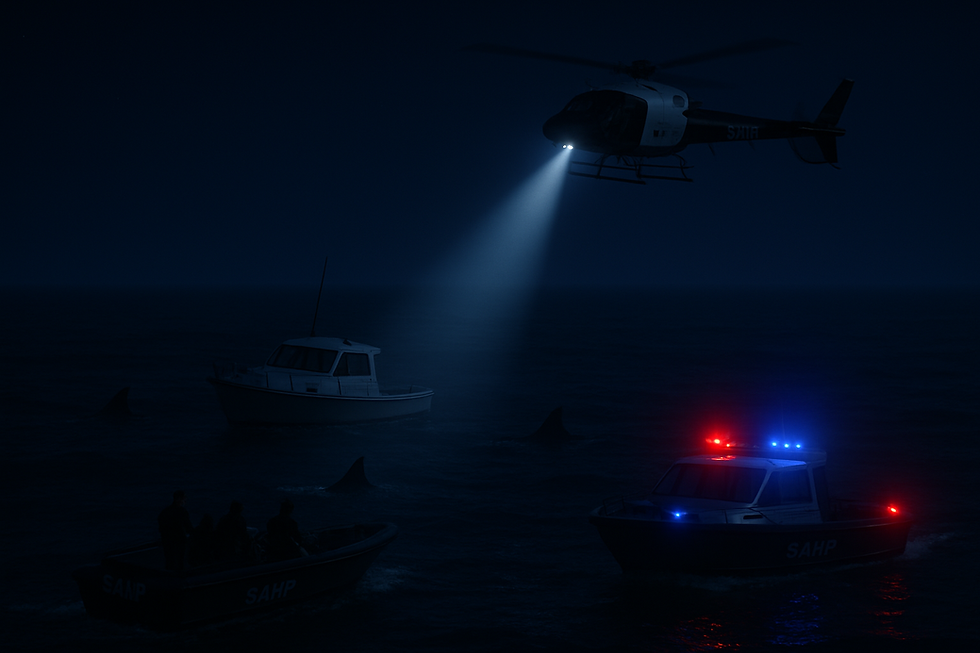“Commander Overboard”: A Midnight Ordeal in the Shark-Infested North
- Damien Maddox

- Aug 6
- 3 min read
Updated: Sep 2

NORTHERN PACIFIC, NORTH OF ROXWOOD — Under the veil of nightfall, in the cold and unforgiving waters north of Roxwood, a routine maritime outing turned into a high-stakes rescue operation fit for a thriller. LSPD Commander Raymond Shields, a seasoned law enforcement veteran, found himself at the mercy of the sea after his vessel lost power and drifted helplessly into a dark stretch of ocean notoriously known by locals and fishermen alike as The Black Maw—a region as infamous for its depth as it is for its predators.
The lone vessel bobbed silently under the stars, swallowed by moonless darkness, as predatory fins circled ominously below. The radio was dead. The engine—unresponsive. The situation—rapidly deteriorating.
A Faint Signal, A Race Against Time
It began with a flicker—a lone distress ping picked up by the regional search grid. The signal was fragmented, barely decipherable, and had already bounced between towers before reaching the Los Santos Emergency Operations Center. But what came through was clear enough: a vessel dead in the water. One man aboard. Immediate threat to life.
From that moment, the race was on.
Mobilizing without hesitation, LSPD Commander Adam Vance, LSPD Officer Max Ward, and SAHP Master Trooper Chris Dallas launched a desperate bid to locate their fellow Commander. Vance and Ward took to the skies aboard Air-1, while Dallas commandeered an SAHP marine unit, cutting through the swells with white and blue beacons screaming against the darkness.
“This wasn’t just a rescue mission,” said Commander Vance. “This was a rescue of our own. We all knew who we were going after—and failure wasn’t on the table.”
Into the Maw
The helicopters cut through the night like falcons, their searchlights illuminating the churning void below. Hours passed with no sign. Then—movement. The light found something.
There, adrift in the open sea, was the faint white silhouette of Commander Shields’ boat, rocking amid shadowy waves. Worse—shark fins were visible breaching the surface, slicing the water like blades. The boat was dead. Shields was seen waving weakly, holding a flare aloft with the last of his strength.
The Rescue
What happened next was nothing short of textbook heroism.
SAHP’s Marine Unit surged forward under Vance’s overwatch, lights flashing, sirens wailing across the dark expanse. Officer Ward and Trooper Dallas performed a coordinated high-speed intercept, executing a parallel docking maneuver beside Shields’ vessel. In a moment that felt suspended in time, the Commander was pulled from the edge of the boat and into the safety of the responding unit just as a large dorsal fin passed within meters of the hull.
“All I saw were teeth and dark water,” Shields recounted later. “I thought that was it. But then I saw those white and blue lights and heard the rotors of the air unit... and I knew I had a shot.”
Shields was immediately triaged on deck for exposure and dehydration before being transported back to the mainland aboard Marine 1.
Brotherhood in Blue
Back on dry land, the camaraderie between the departments was palpable. Shields, visibly shaken but unharmed, embraced each member of the rescue team personally.
“What happened in those waters is proof of what makes our departments great,” he said. “When one of our own is in danger, we don’t hesitate—we respond.”
Moving Forward
As for Shields? He’s expected to return to duty later this week—with a new appreciation for both the sea and the team that came for him.
“That night changed me,” he said. “You never truly know the value of the badge you wear until you see what it means to the people wearing it beside you.”
The successful rescue marks yet another example of seamless interagency coordination between the Los Santos Police Department and the San Andreas Highway Patrol, reinforcing their shared commitment to protecting not only the public—but one another.



Comments